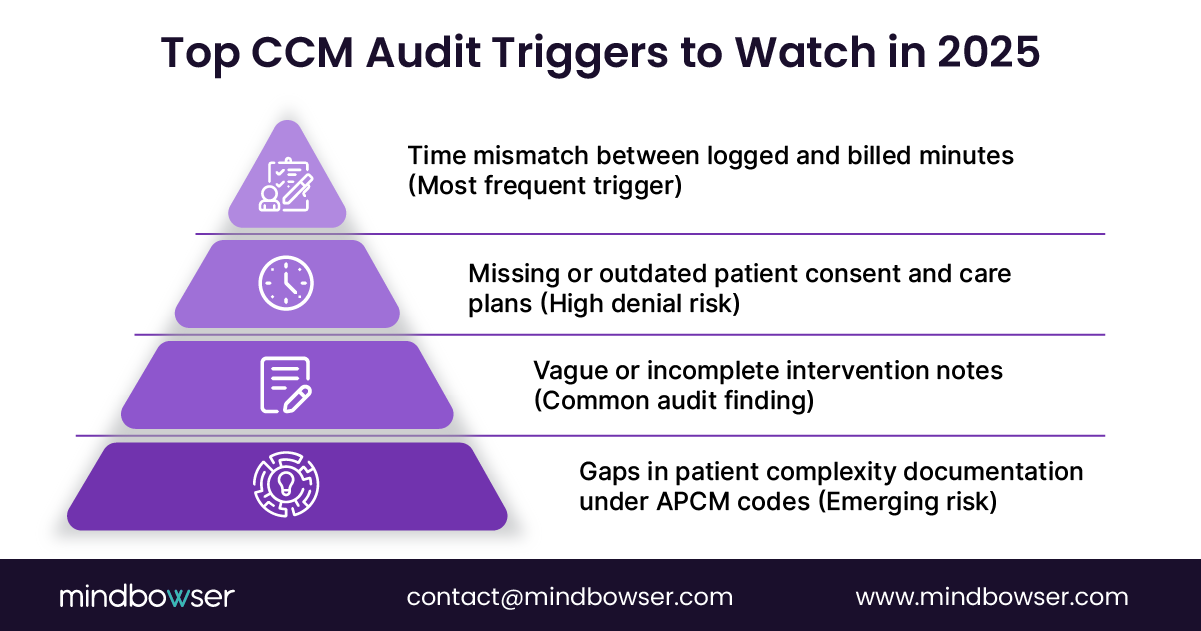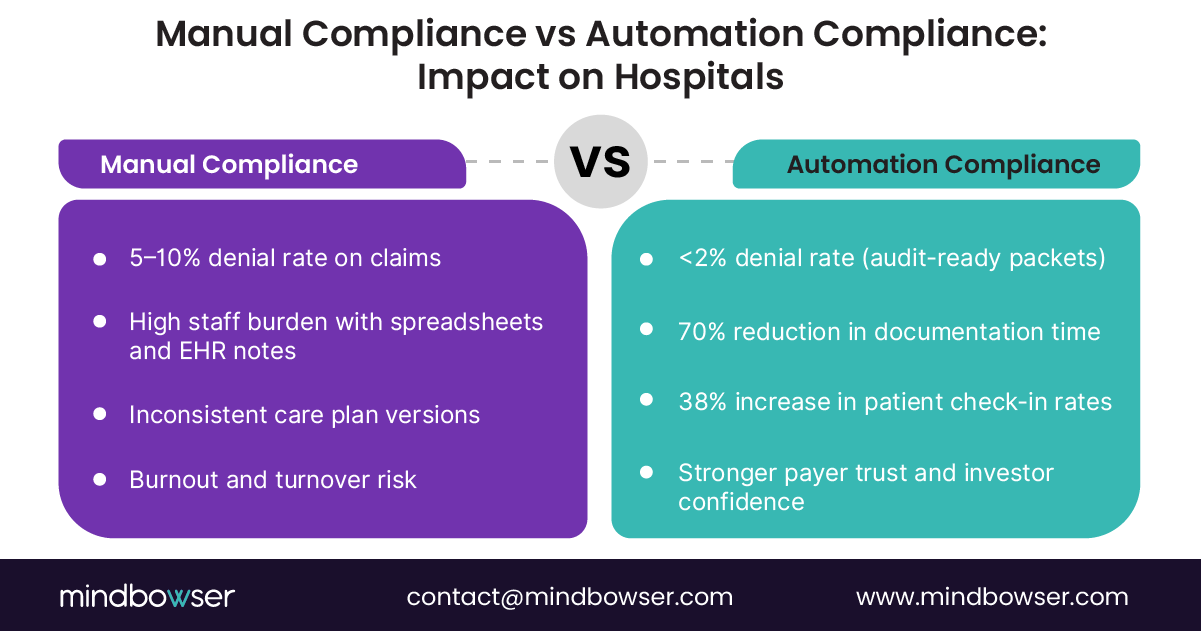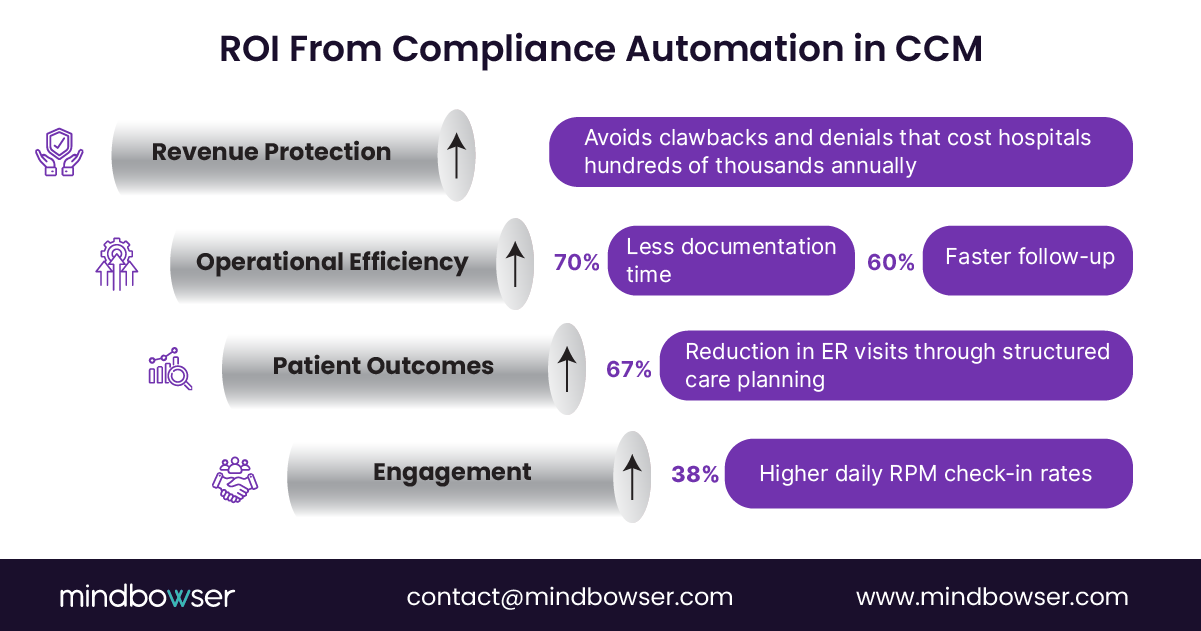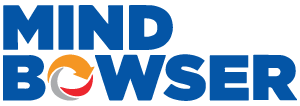Compliance automation in chronic care management is no longer optional. Manual processes create audit risks, billing errors, and revenue leakage. Hospitals and digital health startups are turning to automation and outsourced CCM models to reduce errors, defend audits, and prove ROI. Platforms that embed compliance automation achieve better outcomes, stronger revenue, and reduced staff burnout.
Chronic care management has moved from being a Medicare add-on to a critical program for hospitals, payers, and startups in value-based care. CMS continues to expand reimbursement through CPT and APCM codes, yet every additional billing opportunity brings new compliance requirements. Missing patient consent, incomplete care plans, or mismatched time logs can trigger audits and denials, exposing providers to both financial risk and reputational damage.
Mid-market hospitals managing hundreds of patients and digital health startups scaling nationally face a common challenge: compliance cannot keep up with the operations if it relies on manual workflows. Staff are already stretched thin. When compliance is reduced to chasing spreadsheets, reconciling EHR notes, or piecing together care plan updates, errors are inevitable.
This is where compliance automation changes the equation. By embedding automation into CCM workflows, organizations can generate structured summaries, capture consent through digital forms, and build audit-ready packets without adding administrative burden. For hospitals, this protects millions of dollars in revenue that would otherwise be lost to denials or clawbacks. For startups, it demonstrates to investors and payers that compliance is designed into the platform itself, reducing risk and accelerating growth.
Mindbowser has seen firsthand, through work with partners across behavioral health, rehabilitation, and remote monitoring, how compliance automation enables scale while reducing staff load. In this blog, we will explore compliance risks, why manual approaches fail, the automation tools that matter, and how hospitals and startups can integrate compliance into outsourced CCM models to achieve a measurable ROI.
Chronic care management is one of the few Medicare programs that consistently delivers both clinical and financial returns, but it comes with strict documentation requirements. CMS ties every dollar of reimbursement to time tracking, patient consent, and updates to the care plan. In 2025, with the expansion of new APCM codes, compliance requirements are not only more detailed but also more visible to auditors.
Hospitals and startups alike need to understand that compliance is not simply about avoiding penalties. It is also about securing sustainable reimbursement, protecting margins, and proving credibility in value-based contracts. For mid-market hospitals, a single failed audit can threaten hundreds of thousands in revenue. For digital health startups, weak compliance undermines payer relationships and damages fundraising prospects.
Related read: CCM Audit Risk & Protection: A Compliance Playbook for 2025
Audits in CCM often focus on three failure points.

The importance of compliance is best seen in real-world settings. One behavioral health organization implemented a care optimization suite that automatically attributed staff time, enforced concurrency rules, and tracked referrals in a single workflow. The outcome was a 52% reduction in readmissions and over 250,000 inpatient days avoided. By reducing manual errors, compliance became a driver of clinical and financial improvement.
Another program integrating social determinants of health collected structured data on housing, food security, and transportation. This allowed care teams to create complete care plans that stood up under audit scrutiny. The result was a 67% reduction in emergency room visits for underserved populations. Structured compliance not only protected revenue but also directly improved patient outcomes.
These examples highlight the reality: compliance is not just about checking boxes. It is central to building resilient CCM programs that deliver measurable results. Without automation, however, staying ahead of audit requirements becomes increasingly difficult.
Most hospitals and startups still rely on fragmented processes to manage compliance. Staff track minutes in spreadsheets, enter notes in EHRs, and store consent forms separately. This patchwork creates blind spots, especially when multiple clinicians or care coordinators are involved. Under new APCM codes, where compliance requires both time and patient complexity documentation, these gaps become even more pronounced.
Manual compliance also struggles with scale. A hospital managing thousands of patients across multiple clinics cannot reconcile time logs, care plan versions, and patient outreach without significant overhead. Similarly, a digital health startup scaling nationally cannot afford to rely solely on human review. Manual workflows may be effective for a pilot program, but they often collapse when expanded.
Even well-trained staff make mistakes when juggling compliance tasks alongside patient care. Three patterns stand out.
These issues are amplified in outsourced CCM arrangements when providers assume compliance is covered but still rely on manual reporting.
The consequences of manual errors in CCM compliance are not limited to a few denied claims; they can also result in significant financial losses. The costs extend across financial, operational, and reputational dimensions.

One health system that attempted to manage compliance manually found that documentation inconsistencies across clinics led to repeated denials and significant administrative backlogs. After adopting an integrated compliance automation approach, staff regained over 70% of the time previously spent on reconciliation tasks.
The evidence is clear. Manual compliance may sustain a program in its early stages, but at scale it creates unavoidable risk. Without automation, hospitals and startups are left vulnerable to audits, denials, and workforce fatigue.
Recover lost revenue and prevent denials with automated audit-ready workflows.
Compliance automation is no longer a theoretical concept; it is a practical reality. Hospitals and startups now have access to proven tools that directly address audit triggers.
These technologies eliminate the risk of missed documentation while reducing staff workload. They also provide real-time visibility for compliance leaders, allowing them to track adherence without waiting for monthly reconciliations.
Automation becomes even more powerful when paired with outsourced CCM providers. Many hospitals outsource enrollment, billing, and patient engagement to reduce staffing strain. Without automation, however, outsourcing alone cannot guarantee compliance.
Modern outsourcing models now embed automation directly into workflows. Consent collection is automated through digital forms, care plan updates are logged with version control, and time tracking is reconciled automatically across encounters. This integration ensures that every patient interaction is captured in a centralized, audit-ready record.
One financial assistance platform reduced manual eligibility errors by automating data ingestion from Epic EHR. By aligning automation with compliance requirements, patients were approved more quickly, and staff were freed from repetitive tasks. This type of automation shows how outsourced functions can be made more reliable and defensible under audit scrutiny.
For hospitals, outsourcing combined with automation means reduced overhead and stronger audit defense. For startups, it provides a scalable foundation to demonstrate payer and investor readiness.
The benefits of compliance automation are measurable, not speculative.
The ROI case is straightforward. Automation not only protects revenue from denials and clawbacks but also drives patient outcomes and staff efficiency. For both hospitals and startups, it creates a defensible position in an environment of heightened audit scrutiny.
For mid-market hospitals, compliance automation should be seen as a strategic safeguard rather than an optional upgrade. Hospitals already face shrinking margins, staffing shortages, and increased audit risk due to the expansion of CMS reimbursement codes. The path forward involves embedding automation into daily CCM operations and holding outsourced partners accountable for compliance deliverables.
Hospitals that implement these practices gain both revenue protection and operational relief. Staff can focus on patient care, while compliance leaders gain confidence that every billed claim can withstand scrutiny.
For digital health startups, compliance automation is not just about avoiding denials; it’s also about ensuring seamless operations. It is a differentiator that drives payer trust, accelerates contracts, and builds investor confidence. As startups move from pilot projects to national scale, automation ensures compliance can keep pace with growth.
Digital health companies that fail to automate compliance often find themselves stuck with unsustainable staffing costs or unable to expand payer contracts. Those who invest early in automation not only protect revenue but also stand out in a crowded market.

Mindbowser has built a portfolio of workflows designed to make compliance automation a default feature in CCM programs. These assets enable hospitals and startups to bypass months of custom development, providing a compliance-ready foundation from day one.
Together, these workflows create a compliance ecosystem that eliminates blind spots, strengthens audit protection, and reduces staff burden.
Mindbowser’s compliance approach is built on deep expertise in healthcare regulation. Every CCM solution is designed to align with HIPAA, SOC2, and 42 CFR Part 2 requirements. Beyond certification, Mindbowser provides practical safeguards, such as audit packet assembly, version-controlled care plan workflows, and granular time tracking.
By embedding compliance into the technology fabric, Mindbowser ensures that hospitals and startups can defend every claim with confidence. Instead of scrambling during an audit, organizations have a ready-made compliance archive that includes patient consent, timestamped activities, and intervention notes.
Mindbowser’s work with partners across rehabilitation, behavioral health, and chronic care startups has shown how compliance automation delivers measurable value.
These results prove that compliance automation is not just a protective measure. It directly drives ROI by reducing denials, improving patient outcomes, and lowering the burden on staff. Hospitals safeguard revenue, while startups scale with confidence.

Compliance in chronic care management (CCM) has reached a critical point. As CMS expands reimbursement through CPT and APCM codes, manual compliance methods built on spreadsheets and fragmented EHR notes can no longer keep pace. This creates risks of denials, clawbacks, and administrative fatigue. Compliance automation solves these challenges by embedding AI-driven summaries, automated consent workflows, and audit-ready documentation into daily CCM operations, reducing risk and protecting revenue.
Mindbowser shows that compliance automation drives ROI as well as audit defense. Hospitals cut documentation time and strengthen financial performance, while startups scale confidently with compliance built into their growth model. In today’s value-based care environment, automation is no longer optional; it is the foundation of sustainable reimbursement and measurable impact.
CCM compliance automation refers to the use of technology to capture, validate, and store all documentation required for chronic care management billing. In 2025, with CMS expanding CPT and APCM codes, compliance rules are stricter, and audits are more frequent. Automation reduces human error, ensures audit readiness, and protects hospitals and startups from denials and clawbacks.
Automation reduces audit risk by creating structured, timestamped records of patient consent, care plan updates, and time tracking, ensuring accurate documentation. It ensures that no required element is missed and that every interaction is logged in a consistent format. When audits occur, hospitals and startups can present complete, audit-ready packets without manual reconciliation, protecting revenue and improving compliance confidence.
Manual compliance often fails because it depends on fragmented systems and human oversight. Staff may overlook consent forms, misrecord time, or allow care plan versions to go out of sync. These gaps trigger denials and expose the organization to audit risk. Over time, the administrative burden of manual tracking also leads to staff burnout, turnover, and increased financial risk.
Yes, many outsourced CCM vendors now embed compliance automation into their workflows. This includes digital consent capture, automated care plan updates, and the generation of audit packets. However, hospitals and startups must ensure automation is contractually required and integrated with their EHR systems. Without automation, outsourcing alone may still leave organizations exposed to audit risk and compliance errors.
Hospitals that adopt compliance automation typically experience reduced denials, lower administrative overhead, and improved staff efficiency. Case studies show that documentation time is cut by 70%, patient engagement improves by 38%, and there are significant reductions in readmissions. The ROI comes not only from revenue protection but also from measurable improvements in patient outcomes and stronger payer alignment in value-based care.

We worked with Mindbowser on a design sprint, and their team did an awesome job. They really helped us shape the look and feel of our web app and gave us a clean, thoughtful design that our build team could...


The team at Mindbowser was highly professional, patient, and collaborative throughout our engagement. They struck the right balance between offering guidance and taking direction, which made the development process smooth. Although our project wasn’t related to healthcare, we clearly benefited...

Founder, Texas Ranch Security

Mindbowser played a crucial role in helping us bring everything together into a unified, cohesive product. Their commitment to industry-standard coding practices made an enormous difference, allowing developers to seamlessly transition in and out of the project without any confusion....

CEO, MarketsAI

I'm thrilled to be partnering with Mindbowser on our journey with TravelRite. The collaboration has been exceptional, and I’m truly grateful for the dedication and expertise the team has brought to the development process. Their commitment to our mission is...

Founder & CEO, TravelRite

The Mindbowser team's professionalism consistently impressed me. Their commitment to quality shone through in every aspect of the project. They truly went the extra mile, ensuring they understood our needs perfectly and were always willing to invest the time to...

CTO, New Day Therapeutics

I collaborated with Mindbowser for several years on a complex SaaS platform project. They took over a partially completed project and successfully transformed it into a fully functional and robust platform. Throughout the entire process, the quality of their work...

President, E.B. Carlson

Mindbowser and team are professional, talented and very responsive. They got us through a challenging situation with our IOT product successfully. They will be our go to dev team going forward.

Founder, Cascada

Amazing team to work with. Very responsive and very skilled in both front and backend engineering. Looking forward to our next project together.

Co-Founder, Emerge

The team is great to work with. Very professional, on task, and efficient.

Founder, PeriopMD

I can not express enough how pleased we are with the whole team. From the first call and meeting, they took our vision and ran with it. Communication was easy and everyone was flexible to our schedule. I’m excited to...

Founder, Seeke

We had very close go live timeline and Mindbowser team got us live a month before.

CEO, BuyNow WorldWide

Mindbowser brought in a team of skilled developers who were easy to work with and deeply committed to the project. If you're looking for reliable, high-quality development support, I’d absolutely recommend them.

Founder, Teach Reach

Mindbowser built both iOS and Android apps for Mindworks, that have stood the test of time. 5 years later they still function quite beautifully. Their team always met their objectives and I'm very happy with the end result. Thank you!

Founder, Mindworks

Mindbowser has delivered a much better quality product than our previous tech vendors. Our product is stable and passed Well Architected Framework Review from AWS.

CEO, PurpleAnt

I am happy to share that we got USD 10k in cloud credits courtesy of our friends at Mindbowser. Thank you Pravin and Ayush, this means a lot to us.

CTO, Shortlist

Mindbowser is one of the reasons that our app is successful. These guys have been a great team.

Founder & CEO, MangoMirror

Kudos for all your hard work and diligence on the Telehealth platform project. You made it possible.

CEO, ThriveHealth

Mindbowser helped us build an awesome iOS app to bring balance to people’s lives.

CEO, SMILINGMIND

They were a very responsive team! Extremely easy to communicate and work with!

Founder & CEO, TotTech

We’ve had very little-to-no hiccups at all—it’s been a really pleasurable experience.

Co-Founder, TEAM8s

Mindbowser was very helpful with explaining the development process and started quickly on the project.

Executive Director of Product Development, Innovation Lab

The greatest benefit we got from Mindbowser is the expertise. Their team has developed apps in all different industries with all types of social proofs.

Co-Founder, Vesica

Mindbowser is professional, efficient and thorough.

Consultant, XPRIZE

Very committed, they create beautiful apps and are very benevolent. They have brilliant Ideas.

Founder, S.T.A.R.S of Wellness

Mindbowser was great; they listened to us a lot and helped us hone in on the actual idea of the app. They had put together fantastic wireframes for us.

Co-Founder, Flat Earth

Mindbowser was incredibly responsive and understood exactly what I needed. They matched me with the perfect team member who not only grasped my vision but executed it flawlessly. The entire experience felt collaborative, efficient, and truly aligned with my goals.

Founder, Child Life On Call

The team from Mindbowser stayed on task, asked the right questions, and completed the required tasks in a timely fashion! Strong work team!

CEO, SDOH2Health LLC

Mindbowser was easy to work with and hit the ground running, immediately feeling like part of our team.

CEO, Stealth Startup

Mindbowser was an excellent partner in developing my fitness app. They were patient, attentive, & understood my business needs. The end product exceeded my expectations. Thrilled to share it globally.

Owner, Phalanx

Mindbowser's expertise in tech, process & mobile development made them our choice for our app. The team was dedicated to the process & delivered high-quality features on time. They also gave valuable industry advice. Highly recommend them for app development...

Co-Founder, Fox&Fork
